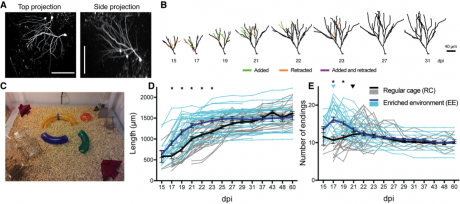Tiago Gonçalves, Ph.D.
Assistant Professor, Dominick P. Purpura Department of Neuroscience
(neuroscience category)

Adult neurogenesis; Neuronal development; Learning and Memory; Aging
The dentate gyrus (DG) is the main input region of the hippocampus. As such, it plays a crucial role in hippocampal function, including learning and memory. Additionally, the DG is one of only two regions of the mammalian brain that continuously add new neurons through adulthood, and there is increasing evidence that these adult-born neurons play a role in specific learning tasks: particularly, the ability to distinguish between similar memories. Adult neurogenesis constitutes an unusual mode of plasticity in the brain, with specific stimuli such as environmental enrichment and voluntary exercise modulating the number of neurons integrating DG networks. In addition, adult-born neurons have been used to study neuronal development, and defects in neurogenesis have been associated with several human neurological and psychiatric diseases. The main focus of my research interests is to understand how enrichment and activity regulate the proliferation of adult neural stem cells and shape nascent adult-born neurons during their integration into DG circuits.

In vivo Ca2+ imaging of different hippocampal areas 3-photon images and Ca2+ traces of neurons expressing a genetically encoded Ca2+ sensor in CA1, DG granule layer and hilus/sub-granular layer. Note differences in morphology and activity patterns betwen cells in these layers. Scale bars: 100% ∆F/F 20 s.

Exposure to an enriched enviroment (EE) leads to faster dendritic growth and earlier pruning (A) In vivo 2-photon images of RV-GFP labeled cells in the DG imaged 60 days post-infection (dpi). Scale bar = 100 µm. (B) Representative reconstructions of the dendrites of two newborn DGCs, branches added and retracted between imaging time points are highlighted. (C) EE cage is large (91×91) cm) and contains running wheels. (D) Individual and mean (bold) plot of dendrite length. (D) Branching of EE dendrites peaks earlier and maximum number of endings is higher than in RC dendrites (adapted from Gonçalves et al. 2016)
Experience and the activity it elicits are powerful modulators of neuronal development. As the brain matures it undergoes several critical periods where specific behavioral experiences (for example environmental enrichment and exercise) are needed for correct circuit formation. In the adult brain, behavioral experience has been shown to influence the proliferation of neural stem cells in the subgranular layer of the DG, their differentiation into glia and neurons, the maturation of these adult-born neurons, and their connectivity and incorporation into hippocampal circuits. Yet many aspects of the effects of experience on adult neurogenesis and hippocampus networks remain poorly understood. In our lab we study the effects of activity and experience at different phases of neuronal development ranging from the neural precursor stage to full maturity. The ability to track individual cells over their maturation period is crucial for our experiments. We use in vivo 2-photon imaging as a powerful tool to study of neuronal development since it allows for the recurrent probing of individual cells and circuits while keeping sensory input, neuronal activity patterns, and the physiological environment intact.
Selected Publications
Mansour A.F., Gonçalves J.T., Bloyd C.W., Li H., Fernandes S., Quang D., Johnston S., Parylak S.L., Jin X, Gage F.H., An in vivo model of functional and vascularized human brain organoids, Nat. Biotechnol. , doi:10.1038/nbt.4127 (2018)
O’Donnell C., Gonçalves J.T., Portera-Cailliau C., Sejnowski T.J., Beyond excitation/inhibition imbalance in multidimensional models of neural circuit changes in brain disorders, eLife, 6:e26724 (2017)
O’Donnell C., Gonçalves J.T., Whiteley N., Portera-Cailliau C., Sejnowski T.J., The population tracking model: A simple, scalable statistical model for neural population data, Neural Computation, 29, 50–93 (2017)
Gonçalves J. T. *, Schafer S.T. * (equal contribution), Gage F.H., Adult neurogenesis in the hippocampus: from stem cells to behavior, Cell, 167, 897–914 (2016) review article
Gonçalves J.T., Bloyd C.W., Shtrahman M, Johnston S.T., Schafer S.T., Parylak S.L., Thanh T., Chang T., Gage F.H., In vivo imaging of dendritic pruning in dentate granule cells, Nat. Neurosci., 19(6), 788–791 (2016) (journal cover)
Poo M.M., Pignatelli M., Ryan T.J., Tonegawa S., Bonhoeffer T., Martin K.C., Rudenko A., Tsai L., Tsien R.W., Fishell G., Mullins C., Gonçalves J.T., Shtrahman M., Johnston S.T., Gage F.H., Dan Y., Long J. Buzsáki G., Stevens C., What is memory? The present state of the engram, BMC Biology, 14(1):40 (2016) opinion article
Mertens J., Paquola A. C. M., Ku M., Hatch E., Böhnke L., Ladjevardi S., McGrath S., Campbell B., Lee H., Herdy J. R., Gonçalves J. T., Toda T., Kim Y., Winkler J., Yao J., Hetzer M. and Gage F. H., Directly reprogrammed human neurons retain age-related transcriptomic signatures and reveal age-related nucleocytoplasmic defects, Cell Stem Cell, 17, 1–14 (2015)
Gonçalves J.T., Anstey J.E., Golshani P., Portera-Cailliau C., Circuit level defects in the developing neocortex of fragile X mice, Nat. Neurosci., 16, 903–09 (2013)
(equal contribution) Cheng A.*, Gonçalves J.T. *, Golshani P., Arisaka K., Portera-Cailliau C., Spatio-temporal excitation-emission multiplexing for multiple beam 2-photon calcium imaging in deep tissue, Nat. Methods., 8, 139–42 (2011)
Golshani P., Gonçalves J.T., Khoshkhoo S., Mostany R., Smirnakis S., Portera-Cailliau C., Internally mediated developmental desynchronization of neocortical network activity, J. Neurosci., 29, 10890–10899 (2009)